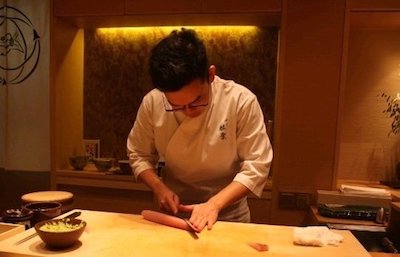We are reader supported. When you purchase through links on our site, we may earn an affiliate commission. Also, as an Amazon affiliate, we earn from qualifying purchases.
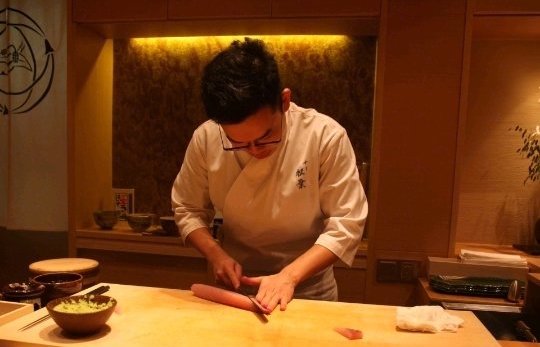
If you have just started taking interest in Japanese cuisine, you may come across several local terms that may perplex you. I don’t blame you because I have been in your shoes several years before. Two of the most confused terms are kaiseki and omakase.
Some people use them interchangeably as if they mean the same thing but actually they are different in many ways. In this post, I will explain what each one refers to and how they are different from each other. Before we go ahead with the differences, let’s talk briefly about the similarities.
Both kaiseki and omakase are Japanese terms and they refer to dining styles, but they differ completely in their formats. They both aim at giving the diners an extremely exclusive dining experience that is not only incredibly delicious but also memorable.
Contents
An Insight Into Kaiseki Meal
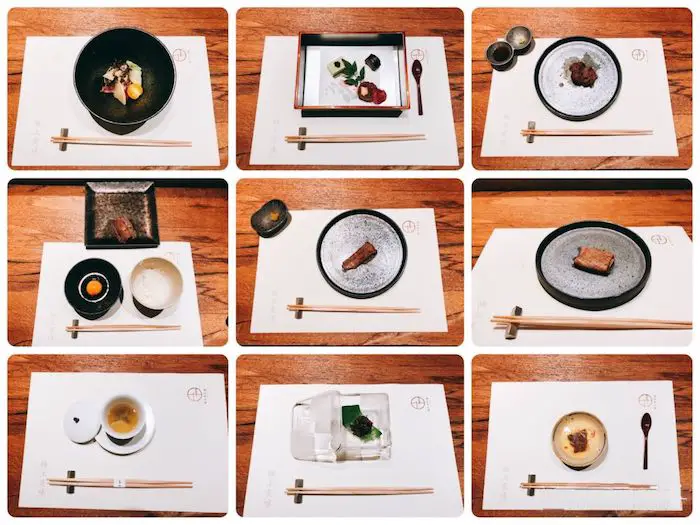
Kaiseki is derived from the term ‘chakaiseki’ which means a traditional Japanese tea ceremony commonly practiced 16th century onwards. It refers to a multi-dish cuisine served before a few cups of matcha. In Japanese Kaiseki means having stones in the bosom and it refers to the custom of monks folding stones in their robes, close to their stomach to ward off hunger.
Another reference of kaiseki comes from the contemporary social gathering where people are seated together. An elaborate meal is served, followed by sake and it is then concluded with a tea service. This simple meal format has highly evolved over these years to become a more lavish service despite the humble cuisine.
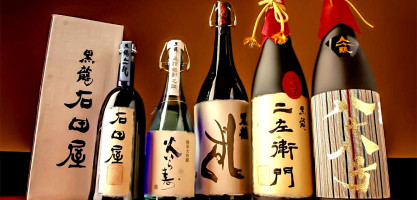
The traditional kaiseki meal is made up of nine courses, however you may find different variations including just 6 or up to 15 courses. The unique courses are identified by their specific method of cooking and some of the popular courses are:
- Sakizuke is usually the first course and it’s designed in a way to pique interest and increase the diner’s appetite for the following courses. It follows the same format as French amuse bouche.
- Hassun is typically referred to as the seasonal course because you will find fresh vegetables and fruits that are in-season. Thus, it marks the seasonality of the meal.
- Suimono is a special soup course that constitutes of delicious dashi broth base.
- Tsukuri is the sashimi course where the chef will serve perfect cuts of high quality fish that are available.
- Yakimono refers to a grilled specialty course where most of meat, fish, seafood, or vegetables are grilled or pad-fried before serving.
- Takiawase is a patiently cooked and simmered dish that may include several vegetables mixed with meat.
- Shokuji is a more filling rice course that usually comes towards the middle and it is served with miso soup and gari (pickled vegetables).
- Mizugashi or Mizumono is the dessert part and may consist of a dish of fresh fruits of Japanese sweets.
An Insight Into Omakase Meal
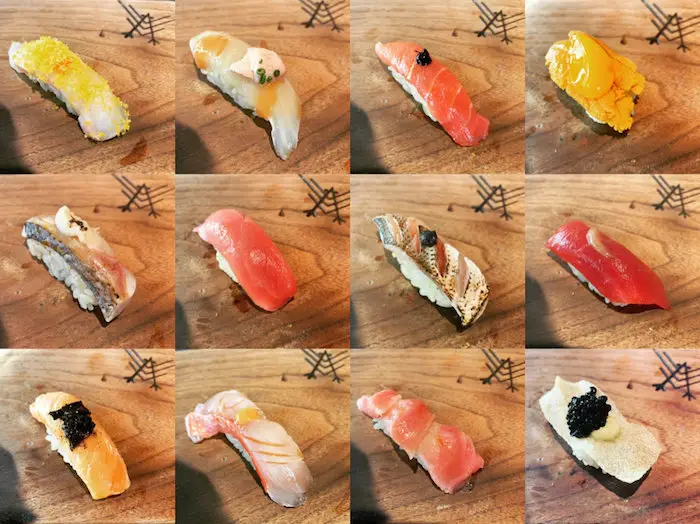
Omakase is the short term used for ‘omakase shimasu’ which can be roughly translated in English as ‘I trust you (chef)’. It gives creative freedom to the chef and an unforgettable experience to guests. In the US, many people mistakenly take it as a tasting menu for the different dishes available at a sushi restaurant, however it has a deeper meaning than that.
When a customer requests for an Omakase meal, he puts his trust on the chef and agrees to go by his judgment of what is best for him. The entire meal is planned by the chef based on what he knows about you (if you are a regular customer) or based on your likings/ preferences during the course of meal.
The chef carefully watches your reactions towards the food and this serves as immediate feedback to give you a memorable dining experience. This is different from the western concept of a tasting menu where you are served food but the chef can’t see your reactions.
This style of dining is common at sushi restaurants but not limited to them. You may also find omakase-style of dining in other types of Japanese cookery such as kushiage (fried skewers), and kushiyaki (grilled skewers). In the skewers course, the chef continues serving till you can eat.
An omakase meal starts with lighter fish and then slowly proceeds to the fattier ones and then rounds up with a sweet dish. According to an experienced Japanese chef, this style of meal is best enjoyed when you come with an open mind to try new experiences and not say ‘I don’t want that’ or ‘I don’t like this’.
A restaurant offering omakase has a great ambience and the chef is friendly and welcoming. There’s no rush to eat quickly as the chef matches your pace and does his best to give you a memorable dinner. Many customers have said that omakase was a transformative experience for them where they learned so much about the origin of fish, the way they are prepared and how to explore new tastes.
5 Things You Must Know Before A Kaiseki Meal
The traditional kaiseki meal is no doubt a classic example of Japanese fine dining. Despite its high price tag, the diner goes home with a wonderful experience. If you are a beginner, it’s natural for you to feel overwhelmed by what you are in for. Here are 5 things you need to bear in mind before ordering a kaiseki meal:
#1. Be mentally prepared to be served a traditional multi-course Japanese meal which is simple and most made of select seasonal ingredients. This is usually treated as a meal before tea.
#2. There’s no standard course for a Kaiseki meal and expect to find a seasonal effect beyond just the ingredients used in food. The chef may also use leaves and twigs for decorating the food. Servers may be dressed in traditional attires signifying that particular season.
#3. Kaiseki meal has a connection with Zen Buddhism hence expect the food to mark simplicity and humbleness. The chef prepares dishes in a way to help diners appreciate the ingredients used in making the dishes.
#4. This is not a everyday meal in Japan and is specially reserved for festivals and special occasions like anniversaries and birthdays. At first glance, a Kaiseki meal ay not impress you with its appearance as it may appear too fragile and delicate. It may take some time to get used to the taste and aroma to appreciate the dish.
#5. Follow some etiquettes such as not taking pictures of the food without permission and even when you are allowed, don’t use flash. Also, avoid wearing a strong cologne or perfume to the restaurant as this may distract fellow eaters. If you have any questions, just ask the staff.
Regardless of whether you are in for Kaiseki dining or not, you must follow some etiquettes in a traditional Japanese restaurant. I have created an in-depth article that explains dos and don’ts while eating out in Japan.
5 Things You Must Know Before An Omakase Meal
#1. An omakase meal only works best in a sushi restaurant where you can find fresh ingredients daily and the chef loves creativity in food. Chain restaurants or noodle shops are not good places to try omakase because they lack that imitate setting and fresh ingredients.
As mentioned above, the culture of omakase dining spells an intimate setting where you are seated close to the kitchen and can see the chef in action. You can enjoy a conversation with the chef as he prepares your meal and watches your reaction towards the food.
#2. An omakase meal is more like a social interaction and the more friendly you are with the chef, it will be easier for him to understand your preferences. Use a few words from the Japanese dictionary to break the ice. Greet the chef by saying itadakimasu before the meal starts and thank for a great experience by saying ‘gochisosama deshita’.
#3. An omakase is not only a taste buds pleasing experience but also helps you gain insight of this Japanese delicacy as the chef explains each dish to you. Listen carefully without asking any personal questions. It’s okay to take pictures of the food, but ask before you take the chef’s photo.
#4. If you have dietary restrictions or you are a picky eater, it is better to avoid an omakase meal. You cannot ask the chef for alterations or adjustments as this will nullify the essence of an ‘omakase’ meal. Be polite and eat what you are offered to broaden your culinary horizon.
#5. Expect to pay a hefty price at the end of the omakase meal. It is usually a stub of paper mentioning the price without any breakdown. While it might give you a good pocket pinch, the price is certainly worth the wonderful experience you get in return.
Difference Between Kaiseki and Omakase
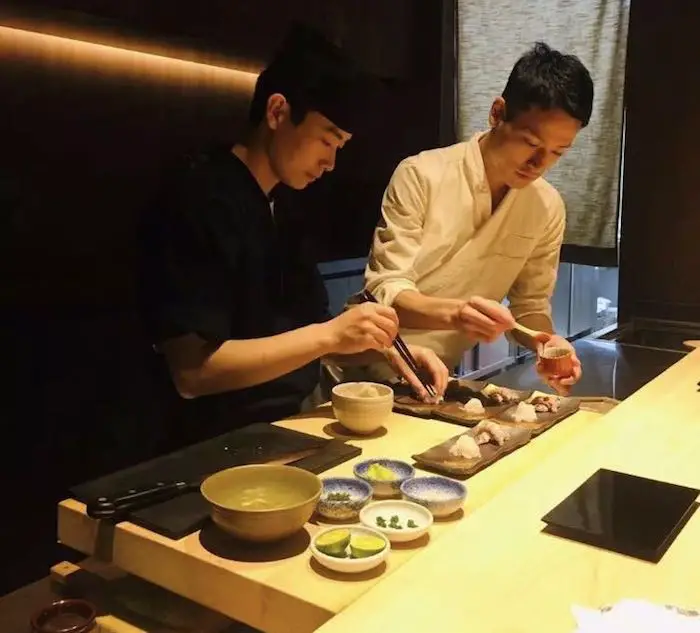
#1. Seating Arrangement
Let’s start with the way you are seated while dining for both the meals. In a restaurant offering Kaiseki, expect a super-traditional style of dining in a private room where you will sit kneeling down on floor mats. The food will be kept on a low table and there will be formally dressed servers serving food to you.
A typically sushi restaurant serving omakase will have tall bar tools around the main kitchen counter where the chef prepares the food. Unlike a Kaiseki, this calls for a more informal setting. The guests will be seated on the tools or chairs, from where they can see how the food is prepared. The chef is your main server here and he loves to indulge in friendly chit-chats.
#2. Interaction With Chef
In a Kaiseki meal, you don’t get to interact with the chef as he will be inside the kitchen most of the time. He does not get any feedback about the food and you don’t have the opportunity to talk to the chef and know how the food is prepared. You get what’s in the pre-defined course.
Restaurants serving omakase have an intimate setting where customers get to interact with the chef directly. The chef gets immediate feedback about the food by reading the customer’s face and offers more of what the customer likes. The chef may also explain how the food is prepared to give you an intriguing experience. You will come out feeling satiated and knowledgeable.
#3. Seasonal Effect
The Kaiseki multi-course meal revolves around the seasonal produce so the main focus is on what is available that season. The food is simple, made from the finest quality ingredients.
The omakase meal is made from the freshest daily ingredients and it’s completely on the sushi chef on what he wants to offer. The menu is not pre-made and mostly depends upon the moment and intuition of the chef. He decides what you will like best.
#4. Price
A Kaiseki meal comes with a high price tag and an authentic dining experience can cost you more than 40,000 yen (369 USD) at a high-end restaurant. Some places may reduce the price to attract more customers so you may expect to find affordable gourmet menus starting from 15,000 yen(138 USD).
An omakase meal comes with a mystery price that the diner pays at the end of the meal. The bill is not itemized so there’s no way to know the individual cost of the items. A large omakase meal may comprise of 15-20 pieces of sushi and sashimi, and you get a rounded price at the end of the meal.
If you are a first timer, expect to get shocked when you are handed the bill but be polite while paying because it’s not just the food but experience that counts more.
#5. The tradition
A kaiseki meal is a pinnacle of Japanese sophistication and it is composed of small dishes that are different from each other in terms of cooking, ingredients, and presentation. Although it is based on Zen Buddhism, you can expect to find meat, soup, and sashimi, besides vegetables and tofu.
Each dish in kaiseki is prepared by the master chef in a traditional style and no two dishes from the same menu will look alike. The ingredients, cooking method and presentation are not repeated.
An omakase meal is about the experience as much as it is about the food. The chef leaves no stones unturned to make the guests feel elated. He starts with some light delicacies and then adds more creativity to the sushi and sashimi pieces as he indulges in knowing the diner’s tastes.
While you don’t know what will come next to your plate in an omakase meal, expect the chef to woo you with his culinary skills and presentation. You will go home not just with a full stomach but also with a happy heart.
| Kaiseki | Omakase |
| Super-traditional Japanese haute cuisine | Creative and unique sushi experience |
| 6-15 small yet unique dishes | 15-20 pieces of sushi and sashimi |
| Meal followed by traditional tea | Meal is followed by sake or Japanese beer |
| High-quality seasonal ingredients | Sushi-grade fish and fresh vegetables |
| No dish/ ingredient is repeated | May include different cuts of the same fish |
| Simple and humble multi-course menu | May contain fatty and rich slices of fish |
| Pre-designed menu | Menuless dining, based on chef’s judgment |
| Diners sit on a floor mat in private room | Diners sit on tools or chairs overlooking the kitchen counter |
| Formal setting, no interaction with chef | Casual setting, chef indulges in a conversation with diners |
| Diners may not know about the ingredients | Chef explains every dish and ingredients explicitly |
| No feedback given to the chef | Your expressions and reactions to food give immediate feedback |
Related Questions
What are the origins of kaiseki and omakase?
Both the gourmet styles have their origin in Japan but the year of origin varies. The roots of Kaiseki tradition go as far as the 9th century (although the form evolved in the 16th century) and this form of multi-course meal made the Japanese inclined to the idea of fine food prepared by the chef.
The Omakase culture has evolved recently and seems to be inspired by the intricate Kaiseki tradition. It’s just that the setting for Omakase is much more casual and the chef decides what you eat.
How many dishes in a kaiseki meal?
A kaiseki meal typically consists of six different dishes that include an appetizer, a simmered dish, sashimi, a seasonal dish, a grilled dish, and a rice dish.
How many dishes in an omakase meal?
An omakase meal may consist of 15-20 different types of sashimi, nigirizushi, sushi rolls, etc. The chef may use different species of fish or different portions of the same fish. The meal typically starts with lighter white fish and then proceeds to the fattier and savory toro slices.
Which is better kaiseki or omakase?
I am not trying to be diplomatic but it’s tough to choose one because each has its own unique character and specialty. I suggest every food enthusiast to enjoy both of these dining styles at least once in their lifetime.
Related Article: Is Sushi Good For A First Date?
An omakase meal is meant for only one person, so sharing is not appropriate. The core essence of the meal is to lay your trust on the chef and he does his best to give you an outstanding experience. This essence is lost when you share the food.

